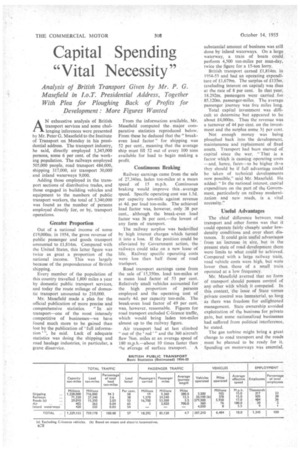Capital Spending "Vital Necessity"
Page 62

If you've noticed an error in this article please click here to report it so we can fix it.
Analysis of British Transport Given by Mr. P. G. Mase.field in 1.o.T. Presidential Address, Together With Plea for Ploughing Back of Profits for Development : More Figures Wanted
AN exhaustive analysis of British transport services and some challenging inferences were presented by Mr. Peter G. Masefield to the Institute of Transport on Monday in his presidential address. The transport industry, he said, directly employed 1,345,000 persons, some 6 per cent, of the working population. The railways employed 505,000 people, road transport 484,000, shipping 317,000, air transport 30,000 and inland waterways 9,000.
Adding those employed in the transport sections of distributive trades, and those engaged in building vehicles and equipment to the numbers of public transport workers, the total of 3,340,000 was found as the number of persons employed directly for, or bY, transport operations.
Greater Proportion
Out of a national income of some £19,000m. in 1954, the gross revenue of public passenger and goods transport amounted to £1,814m. Compared with the United States, this latter figure was twice as great a proportion of the national income. This was largely because of the preponderance of British shipping.
Every member of the population of this country travelled 1,800 miles a year by domestic public transport services, and today the route mileage of domestic transport amounted to 210,000.
Mr. Masefield made a plea for the official publication of more precise and comprehensive statistics. " In air transport—one of the most intensely competitive of businesses—we have found much more to be gained than lost by the publication of ' full information ' ", he said. Lack of adequate statistics was doing the shipping and road haulage industries, in particular, a grave disservice. From the information available,, Mr. Masefield computed the major comparative statistics reproduced below. From these he deduced that the " breakeven load factor" for shipping was 52 per cent., meaning that the average ship must fill 52 out of every 100 tons available for load to begin making a profit.
Continuous Braking Railway earnings came from the sale of 27,340m_ laden ton-miles at a mean speed of 15 m.p.h. Continuous braking would improve this .-average speed. Specific operating cost was 1.5d. per capacity ton-mile against revenue at 4d. per load ton-mile. The achieved load factor was, however, only 38 per. cent., although the break-even load factor was 36 per cent.—the lowest of any form of transport.
The railway surplus was bedevilled by high interest charges which turned it into a loss. If the position could be alleviated by Government action, the railways could take on a new lease of life. Railway specific operating costs were less than half those of road tran'sport.
Road transport earnings came from the sale of 15,350m. load ton-miles at a mean load factor of 53 per cent. Relatively small vehicles accounted for the high proportion of persons employed and the operating cost of nearly 4d. per capacity ton-mile. The break-even load factor of 49 per cent. was, however, reasonable. Figures for road transport excluded C-licence traffic, which would bring laden ton-miles almost up to the railway figure.
Air transport had at last climbed "out of the ' red '" and the 360 aircraft flew 76m. miles at an average speed of 180 m.p.h.—about 10 times faster than 'he average of surface transport. • A substantial amount of business was still done by inland waterways. On a large waterway, a train of boats could perform 4,500 ton-miles per man-day, twice the figure for a 15-ton lorry.
British transport earned £1,814m. in 1954-55 and had an operating expenditure of £1,679m. The surplus of £135m. (excluding interest on capital) was thus at the rate of 8 per cent. In that year, 18.292m. passengers were carried for 85,I20m. passenger-miles. The average passenger journey was five miles long.
Total capital investment was difficult to determine but appeared to be about £4,000m. Thus the revenue was a turnover of 44 per cent. on the investment and the surplus some 3.1 per cent.
Not enough money was being ploughed back into The development, maintenance and repladement of fixed assets. Transport had been starved of capital since the war. "That is a factor which is causing operating costs —and, hence, fares—to be higher tlrin they should be if full advantage could be taken of technical developments now possible," said Mr. Masefield. He added: "In the national interest, capital expenditure on the part of the Government, particularly on railway modernization and new roads, is a. vital necessity."
Useful Advantages
The chief difference between, road transport and other forms was that it could operate fairly cheaply under lowdensity conditions and over short distances. It could gain useful advantages from an increase in size, but in the present state of road development there were limits to what could be achieved. Compared with a large railway train, road vehicle costs were high. but were lower than those of a small train operated at a low frequency.
Mr. Masefield averred that no form Of transport should possess control of any other with which it competed. In this context, the issue of State versus private control was immaterial, so long as there was freedom for enlightened management. State ownership avoided exploitation of the business for private gain, but some nationalized businesses had suffered from political interference, he stated.
The gas turbine might bring a great change to road transport and the roads must be planned to be ready for it. Spending on motorways was essential.




















































































































